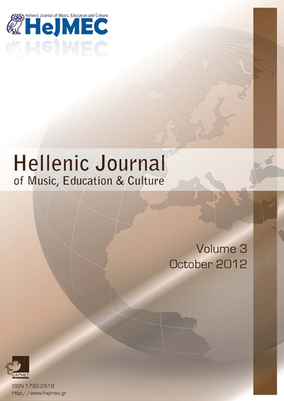Risks and Promises of ICT for Music Education
Part of : Hellenic journal of music, education and culture ; Vol.1, No.1, 2010, pages 17-31
Issue:
Pages:
17-31
Author:
Abstract:
This article discusses about the conditions influencing the usage of the Information and Communication Technologies (ICT) in the music classroom. Peter Webster (2002) considers three circumstances allowing or restraining how ICT is employed in music education: (1) technological development; (2) availability and integration; and (3) a constructivist approach being followed for teaching and learning. I will discuss a fourth feature: the similarity between the musical concept supported both by ICT and the school curriculum. I will develop these four circumstances and provide illustrations from a European context. In the ending, I will conclude that the potentiality of teaching materials that use ICT for music education by can be jeopardized for global and economic interests beyond schools. ICT is more than being proficient using technologies, but also being an active reader of mass media productions. Teachers should be aware of both potentials and risks to promote reflective listeners and thinkers rather than reproductive listeners and consumers.
Subject:
Subject (LC):
Keywords:
music technology, information and communication technology
References (1):
- Adorno, T.W. & Eisler, H. (1981). El cine y la música. Madrid: Fundamentos.Berger, J. (1972). Ways of seeing. London: BBC / Penguin.Burbules, N. (2000). Watch IT: the risks and promises of information technologies for education.Boulder: Westview Press.Burgess, J. (2003). Genre, creativity and the mastery of techonologies in Brisbane’s contemporarymusic scene. Available at http://www.members.optusnet.com.au/creativitymachine/sonics.htmlCaputo, V. (1993-1994). Add technology and stir: Music, gender, and technology in today’s musicclassrooms. Quarterly Journal of Music Teaching and Learning, 4-5 (4-1): 85-90.Consejería de Educación y Ciencia de la Junta de Andalucía (2003a). And@red. Plan educativopara el impulso de la sociedad del conocimiento. Unpublished.(2003b). Orden de 27 de marzo de 2003 por la que se regula la convocatoria de selección deProyectos Educativos de Centro para la incorporación de las tecnologías de la informacióny la comunicación a la práctica docente. Boletín Oficial de la Junta de Andalucía(B.O.J.A.), 65: 7035-7040.(2003c). Orden de 27 de marzo de 2003 por la que se regula la convocatoria de selección deProyectos de Centro Digitales. B.O.J.A., 65: 7041-7045.II Congreso Internacional de EducaRed (2003). Hacia una nueva reformulación de la tareadocente. Escuela Española, suplementum #2: I-IV.McLean, L. (2001). Metamorphosis of YNN. An evaluation of the pilot program of the Youth NewsNetwork. The Ontario Institute of Studies in Education, Toronto.Muriel, S. (2007). Impulsamos la educación en red. IV Congreso Internacional de EducaRed.Educar en comunidad. Available athttp://www.educared.net/congresoiv/docs/experiencias/BLOQUE%20INTEGRACI%D3N%20TIC%20TENDENCIAS/Impulsando%20educaci%F3n%20en%20Red/Educacion%20en%20Red_Red.es.pdfMasterman, L. (1993). La enseñanza de los medios de comunicación. Madrid: de la Torre.Nieto, J. (1996):: Música para la imagen. La influencia secreta. Madrid: S.G.A.E.Reese, S. & Hickey, M. (1999). Music technology in Illinois public schools. Update, 18 (2): 27-32.Roca, F. (1998). La informática musical en el aula de música. Eufonía, 13, 37-47.Sampaio, M. (1998). La sombra de la imagen. Eufonía, 13: 15-23.Sancho, J. M. (2001). Para una tecnología educativa. Barcelona: Horsori.Schafer, R. M. (1994). Hacia una educación sonora. Buenos Aires: Pedagogías Musicales Abiertas.Shuker, R. (2001). Understanding popular music. London: Routledge.Technology counts: 1999 National survey of teachers‟ use of digital content (2000). Available at http://www.edweek.org/sreporls/99/articles/survey.htmThéberge, P. (1999). Technology. In Horner, B. & Swiss, T. (ed.): Key terms in popular music andculture. Oxford: Blackwell.Webster, P. (2002). Computer-based technology and music teaching and learning. In ColweII, R.& Richardson, C. (eds.): The new handbook of research on music teaching and learning.New York: MENC / Oxford University Press.




